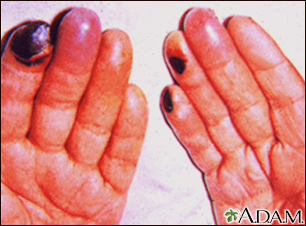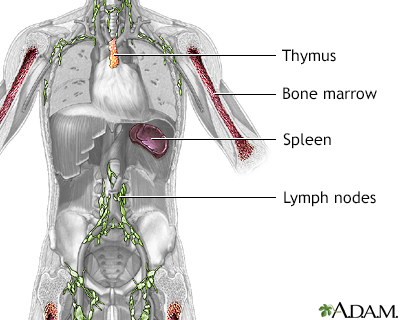Multiple myeloma
Plasma cell dyscrasia; Plasma cell myeloma; Malignant plasmacytoma; Plasmacytoma of bone; Myeloma - multiple
Multiple myeloma is a blood cancer that starts from a type of white blood cell in the bone marrow called plasma cells. Bone marrow is the soft, spongy tissue found inside most bones in children and in the front chest bone (sternum) and the pelvis bones in adults. The bone marrow makes blood cells.
Plasma cells help your body fight infection by producing proteins called antibodies. In people with multiple myeloma, abnormal plasma cells grow out of control in the bone marrow and form tumors in the areas of solid bone. The growth of these bone tumors weakens the bones. It also makes it harder for the bone marrow to make healthy blood cells and platelets.

Cryoglobulinemia is caused by an abnormal protein that is occasionally found in the blood of people with multiple myeloma, leukemia, and certain forms of pneumonia. It causes blood to gel at low temperatures. In this picture, cryoglobulinemia has reduced blood flow in the fingers so much the fingers have turned dark. The black areas are gangrene resulting from lack of blood flow.

The immune system protects the body from potentially harmful substances. The inflammatory response (inflammation) is part of innate immunity. It occurs when tissues are injured by bacteria, trauma, toxins, heat or any other cause.

Antigens are large molecules (usually proteins) on the surface of cells, viruses, fungi, bacteria, and some non-living substances such as toxins, chemicals, drugs, and foreign particles. The immune system recognizes antigens and produces antibodies that destroy substances containing antigens.
Causes
The cause of multiple myeloma is unknown. Past treatment with radiation therapy increases the risk for this type of cancer. Multiple myeloma mainly affects older adults.
Symptoms
Multiple myeloma most commonly causes:
- Low red blood cell count (anemia), which can lead to fatigue and shortness of breath
- Low white blood cell count, which makes you more likely to get infections
- Low platelet count, which can lead to abnormal bleeding
As the cancer cells grow in the bone marrow, you may have bone pain, most often in the ribs or back.
The cancer cells can weaken bones. As a result:
- You may develop broken bones (bone fractures) just from doing normal activities.
- If cancer grows in the spine bones, it can press on the nerves. This can lead to numbness or weakness of the arms or legs.
- Frequent infections may occur.
Exams and Tests
Your health care provider will perform a physical exam and ask about your symptoms.
Blood tests are needed to diagnose this disease. These tests may include:
- Blood calcium level
- Blood total protein level
- Kidney and liver function
- Complete blood count (CBC) and white blood cell differential
- Free light chains
- Immunofixation
- Quantitative immunoglobulins
- Serum protein electrophoresis
- Urine protein electrophoresis
Bone x-rays, CT scans, MRI, or PET scan may show fractures or hollowed out areas of bone. If your provider suspects this type of cancer, a bone marrow biopsy will be performed.
Bone density testing may show bone loss.
Treatment
People who have no damage to their bones or body or in whom the diagnosis is not certain are usually closely monitored without giving treatment. This is called smoldering myeloma which can sometimes progress to myeloma that needs treatment.
Various types of medicines are used to treat multiple myeloma. They are most often given to prevent complications such as bone fractures and kidney damage.
Radiation therapy may be used to relieve bone pain or to shrink a tumor that is pushing on the spinal cord.
A bone marrow transplant may be recommended:
- An autologous bone marrow or stem cell transplantation is performed using a person's own stem cells.
- An allogeneic transplant uses someone else's stem cells. This treatment has additional risks, but may offer the chance of a cure. However, this is rarely used today.
You and your provider may need to manage other concerns during your treatment, including:
Support Groups
You can ease the stress of illness by joining a cancer support group. Sharing with others who have common experiences and problems can help you not feel alone.
Outlook (Prognosis)
The outlook depends on the person's age and the stage of disease. In some cases, the disease progresses very rapidly. In other cases, it takes years for symptoms to appear.
In general, multiple myeloma is treatable, but only in rare cases can it be cured.
Possible Complications
Kidney damage that may lead to kidney failure is a frequent complication. Others may include:
- Bone fractures
- High level of calcium in the blood (hypercalcemia), which can be very dangerous
- Increased chances for infection, especially in the lungs (pneumonia)
- Anemia
When to Contact a Medical Professional
Contact your provider if you have multiple myeloma and you develop an infection, or numbness, loss of movement, or loss of sensation.
References
National Cancer Institute website. Plasma cell neoplasms (including multiple myeloma) treatment (PDQ) - health professional version.
National Comprehensive Cancer Network website. NCCN clinical practice guidelines in oncology: multiple myeloma. Version 1.2025.
Rajkumar SV, Dispenzieri A. Multiple myeloma and related disorders. In: Niederhuber JE, Armitage JO, Kastan MB, Doroshow JH, Tepper JE, eds. Abeloff's Clinical Oncology. 6th ed. Philadelphia, PA: Elsevier; 2020:chap 101.
Rajkumar SV. Plasma cell disorders. In: Goldman L, Cooney KA, eds. Goldman-Cecil Medicine. 27th ed. Philadelphia, PA: Elsevier; 2024:chap 173.
Version Info
Last reviewed on: 2/3/2025
Reviewed by: Warren Brenner, MD, Oncologist, Lynn Cancer Institute, Boca Raton, FL. Review provided by VeriMed Healthcare Network. Also reviewed by David C. Dugdale, MD, Medical Director, Brenda Conaway, Editorial Director, and the A.D.A.M. Editorial team.
